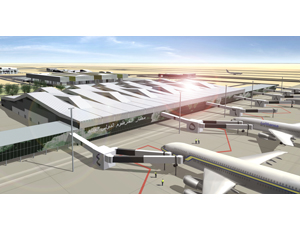
A booming economy fueled by growing tourism numbers and commodity trade volumes has spurred a flurry of airport construction in Africa, with at least four major projects currently under way.
Africa’s annual passenger traffic level hit 133.5 million in 2011, according to Airports Council International estimates. When the airports in Sudan, Rwanda, Kenya and Egypt, now at different stages of implementation, are completed, an additional 36.8 million passengers will be accommodated.
Despite setbacks due to United Nations sanctions over the Darfur conflict, Sudan is pushing ahead with the $1.2-billion Khartoum New International Airport, 22 kilometers from the center of the capital, Khartoum.
The Kuwait Fund for Arab Economic Development and the Islamic Development Bank have given, respectively, $47 million and $120 million for the project.
“Institutions and funds financing the project include a number of Arabic funds, the Ex-Im Bank from Turkey and the [Ex-Im Bank from China] in addition to the Islamic Bank for Development, which has provided the project with $150 million,” says Abdul Karim Abdullah, a state official in charge of the project in Khartoum. Most of these banks also finance companies involved in the exploration and production of oil in Sudan.
The government has chosen German firm Dorsch Consult Airports GmBH to be the program manager. The Chinese state-run firm China Harbour Engineering Co., a subsidiary of the majority state-owned contracting giant China Communications Construction Co., was tapped to build an 89,999-square-meter terminal, two parallel runways, one cross-taxiway, two parallel taxiways and a 56.1-m-high control tower. The facilities will occupy 20 sq km of the airport’s total area of 79 sq km. The two runways, two kilometers apart, will each be 4,000 m long and 75 m wide with 15-m-wide shoulders.
The Khartoum airport will have an annual capacity of 7.5 million passengers, the equivalent of 12% of Africa’s total passenger traffic in 2010. Further, it will handle 780,000 flights a year.
A similar, slightly smaller airport is being constructed in East Africa’s fastest-growing economy, Rwanda, 25 kilometers east of the capital, Kigali.
Bugesera International Airport, which will replace the capacity-constrained Kigali Airport, will be constructed in four phases. Phase one, estimated at $325 million, will entail construction of a 4.2-km-long runway, with room for a second as well as new taxiways, aprons, air-traffic-control facilities, passenger-cargo terminal buildings, access roads and utilities.
Construction will start in first quarter of 2013 and be completed in 2016. The procurement process is under way, with nine contractors short-listed for the 25-year design-build-finance-maintain-operate concession agreement, according to transaction advisers PricewaterhouseCoopers Associates Africa Ltd.
An initial technical and feasibility study by the U.K.’s TPS Consult put the cost of the entire project at $600 million, although Rwanda is now seeking cut it down to between $300 million and $400 million.
In its design-team report to the Rwanda government, TPS Consult noted a major challenge when actual construction starts: optimizing the design of large-scale earthworks to provide a cut-fill balance on a site with variable topography.
A total of 38 million cu m of material will need to be moved to achieve a working platform, according to a presentation by TPS Consult’s former technical director, Hanif Macci, now regional director in Dubai.
“The site is remote and carries a lack of utilities. All services required for a functional airport, such as electricity, fuel and water, will need to be sourced and provided,” Macci said.
One of the largest airports to be operating in the East Africa region once it is built and commissioned, the airport will increase annual passenger capacity by 1.8 million, with an initial peak-hour capacity of 450 passengers in 2016.
Kenya, which boasts the region’s largest economy, is also constructing the new, $595-million greenfield passenger terminal at Jomo Kenyatta International Airport (JKIA). It will have an annual passenger capacity of 20 million.
The contract for the project, sponsored by Kenya Airports Authority (KAA), a state-run airports’ operator, had been awarded to China’s Anhui Construction Engineering Group. The tender has, however, run into problems. Kenya’s transportation minister, Amos Kimunya, recently suspended it and called for a re-bid.
“Out of 120 bidders, only one succeeded. It surprised us how the same bidder was fast-tracked, granted approval, sent notification letters to China and received acknowledgement within three days,” the minister told parliament in mid-August. He said the KAA board had refused to approve the deal with Anhui after the tender sum increased to $655.8 million from $500 million.
Regarding the minister's decision, Anhui has appealed to the Public Procurement Oversight Authority, an independent state-run firm, for a review of the contract termination. A verdict is still pending.
Philemon Otiende, KAA’s general manager for projects and engineering services, says the new terminal, which has a floor area of 172,000 sq m, will have 50 international check positions, 32 contact gates and eight remote gates. It will also have an apron with 45 aircraft stands that link to taxiways, land-side and air-side roads, and other utilities.
A new terminal at the JKIA is critical for Kenya’s aviation industry. The airport, the largest in central and East Africa, contributes an average 11% to Kenya’s GDP. Annual passenger and cargo-volume growth rates stand at 12% and 10%, respectively.
“The expansion and upgrading works at Jomo Kenyatta International Airport terminal will increase handling capacity and address the all-important aspect of aviation safety and security while increasing revenue generation and compliance to international standards,” says George Muhoho, immediate former managing director at KAA.
JKIA is also the operating base of Kenya’s national carrier, Kenya Airways, which currently serves 53 destinations worldwide, 42 of them in Africa. At least 36 international and domestic airlines operate at JKIA, where cargo volumes have reached 300 million kilograms a year.
“The increase in capacity will unlock the suppressed growth in traffic, which will stimulate other sectors of the economy such as tourism, horticulture exports and business travel,” said Mugo Kibati, director of Visions 2030, Kenya’s 30-year economic development plan. The project is expected to break ground in November.
In Egypt, one of the projects that defied the bloody revolution that toppled former strongman Hosni Mubarak is expected to be completed by 2015.
Turkish firm Limak Construction, a flagship company of Limak, is handling modernization of the 123,000-sq-m Terminal 2 at Cairo International Airport, which ended operations in 2010 to allow for work to start.
The $387-million renovation contract was awarded last year, and the three-year upgrading is expected to commence by the end of this year. The existing facilities will be refurbished, and a new departure hall and gate will be built.
The renovation, with financial support from the World Bank, will increase the terminal’s annual passenger capacity to 7.5 million and Cairo International Airport's overall passenger capacity to 25 million.
“The new terminal building will operate jointly as one integrated terminal, thus reinforcing the role of Cairo International Airport as a regional hub,” the bank said in a statement. “Terminal 2 will host the new Airport Operations Control Center to monitor and manage all airport and hub operations from one centralized location.”
The bank also notes that, given the “increased complexity of the air transport sector, the project will include a component to strengthen the institutional capacity of the sector's institutions.”
Cairo International Airport, the second-largest airport in Africa after South Africa’s Johannesburg airport, says that, once the terminal is completed, the number of gates will increase to 14 from seven and include new Airbus A380 facilities.
The project is sponsored by the Egyptian Holding Co. for Airports and Air Navigation, while its subsidiary, Cairo Airport Terminals Co., will provide the remaining funding.


Post a comment to this article
Report Abusive Comment